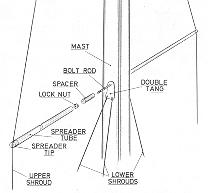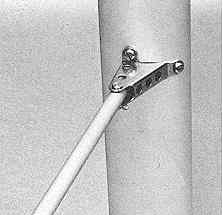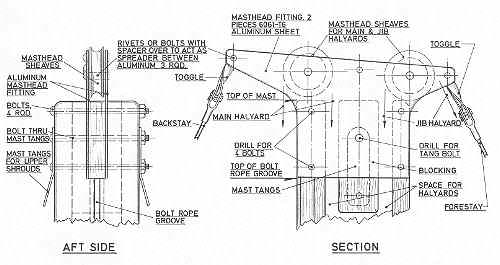Rigging Small Sailboats
Chapter 3
.....spar components
Page 3Two types of spreaders are used. One is the fixed-type where the spreader is rigidly mounted to the mast such as shown in Fig. 3-7. The other type is the pivoting or swinging type which is allowed to swing horizontally along a pivot point located on the mast. This type is illustrated in Fig. 3-8. Use the type specified for the boat you have in any case. Where the shrouds pass over or through the spreaders, there should be special fittings or spreader tips which prevent chafing of the shroud by the spreader. Often the spreader tips are adjustable in order to vary the tension of the shrouds. Most spreader tips have an open groove or hole through which the spreader passes. Note that the shrouds are allowed to move or slide on their own against the spreader tip. However, with the open groove type, some means of lashing or taping the shroud to the spreader tip must be provided. The reason for this is that when sailing at an angle of heel, the WINDWARD* shroud will be taut, and the LEEWARD* shroud becomes slack, which could allow the shroud to fall out of the leeward groove if not secured in place.
*WINDWARD - Toward the direction from which the wind is
blowing.
*LEEWARD - Downwind, or with the direction of the wind.
Two other types of spreaders which are used for supplemental strengthening of the mast, or to combat localized stresses, are DIAMOND SPREADERS and JUMPER STRUTS (see Fig. 4-4 'a'). Diamond spreaders are cross members in pairs always used in conjunction with DIAMOND STAYS, which are wire rope stays fixed at either end to the mast. The diamond spreader "spreads out" the diamond stays at their mid-length each side of the mast. The term diamond comes from the fact that when the diamond stays and spreaders are in position, they form a shape like a diamond. An exception to this is when more than one diamond spreader pair is used per stay. Diamond spreaders are just like regular spreaders, except that they are usually smaller and shorter in length.
The jumper strut is usually used only on jibhead rigs to reinforce the upper part of the mast. The jumper strut is located on the forward side of the mast jutting out horizontally forward, and combats the strain of the mainsail pulling aft on the mast. The JUMPER STAY passes through the strut, and is fastened to the mast at each end of the stay. The jumper strut is usually positioned to bisect the length of the jumper stay. Diamond stays and jumper stays are not required on all boats; just on those masts which require additional support.

FIG. 3-7 An example of fixed spreaders. This spreader fitting consists of a bolt or threaded rod through the mast, with a spacer on either side, that matches the inside diameter of the spreader tubing. The spreaders are aluminum tubing with sloted tips for the shrouds. This fitting can be used on either wood or aluminum masts. |

FIG. 3-8 These spreaders pivot on a horizontal plane. The fittings fasten to the sides of the mast and the spreaders are pin-fastened to them. By being able to pivot, the spreaders will align themselves to the ideal position when sailing to windward. |

FIG. 3-9 Masthead fitting for a wood mast on a masthead rig. This fitting can be easily made by the home builder. Aluminum plate is used to keep weight to a minimum, which is critical to stability when located aloft. The toggles allow a universal swivel action to the stays, thereby eliminating bending of the stay at the swaged fitting. Note that the halyards are running inside the mast. |
|